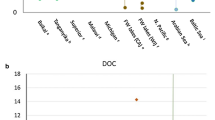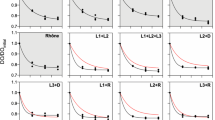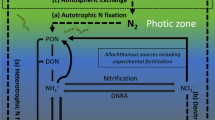Abstract
The dissolved organic carbon (DOC) of lakes dominates any budget of organic carbon in these systems. Limnologists are still limited by techniques and particularly by the lack of measurements of rates of microbial transformation and use of this DOC.
There are now four different approaches to the study of the microbial control of DOC in lakes. The first is through measurements of the total DOC. Recent advances in measurement with high temperature combustion will likely lead to higher and more consistent measurements in freshwaters than previously. It is possible that a biologically active fraction may be identified. The second approach is through measurements of microbial incorporation and respiration of 14C-labeled organic matter. The kinetics of this process are well known but advances in measurement of the size of the substrate pool are still being made. The third approach is to use bacterial growth in batch or continuous flow experiments in order to understand how much of the total DOC can be decomposed by microbes. The assay in this approach may be microbial growth (thymidine incorporation, biomass changes) or change in the DOC (total concentrations, specific compounds, or fractions of the DOC by molecular weight). These methods are promising but are not developed enough for routine use. For example, growth measurements in the laboratory are all subject to experimental artifacts caused by changes in the DOC and in the bacterial populations. Finally, the fourth approach is through the use of isotopes of the natural DOC. In the sea this approach has given the age of the bulk DOC (14C data). In freshwaters it has great potential for differentiating between bacterial use of terrestrial DOC vs. use of algal-derived DOC (13C data). Stable isotopes are also useful for experimentally labeling DOC produced by algae and following the use of this material by bacteria.
Similar content being viewed by others
References
Ammerman, J. W., J. A. Fuhrman, A. Hagström & F. Azam, 1984. Bacterial growth in seawater. I. Growth kinetics and cellular characteristics in seawater cultures. Mar. Ecol. Prog. Ser. 18: 31–39.
Bell, R. T. & J. Kuparinen, 1984. Assessing phytoplankton and bacterioplankton production during early spring in Lake Erken, Sweden. Appl. envir. Microbiol. 48: 1221–1230.
Bjornsen, P. K., 1986. Bacterioplankton growth yield in continuous seawater cultures. Mar. Ecol. Prog. Ser. 30: 191–196.
Burney, C. M., P. G. Davis, K. M. Johnson & J. M. Sieburth, 1981. Dependence of dissolved carbohydrate concentrations upon small scale nanoplankton and bacterioplankton in the western Sargasso Sea. Mar. Biol. 65: 289–296.
Coffin, R. B., B. Fry, B. J. Peterson & R. T. Wright, 1989. Carbon isotopic compositions of estuarine bacteria. Limnol. Oceanogr. 34: 1305–1310.
Coffin, R. B., D. J. Velinsky, R. Devereux, W. A. Price & L. A. Cifuentes, 1990. Stable carbon isotope analysis of nucleic acids to trace sources of dissolved substrate used by estuarine bacteria. Appl. envir. Microbiol. 56: 2012–2020.
Cole, J., 1985. Decomposition. In G. E. Likens (ed.) An Ecosystem Approach to Aquatic Ecology. Springer-Verlag, New York, Berlin, Heidelberg, Tokyo: 302–310.
Cole, J. J., S. Findlay & M. Pace, 1988. Bacterial production in fresh and saltwater ecosystems: A cross-system overview. Mar. Ecol. Prog. Ser. 43: 1–10.
Coveney, M. F., 1982. Bacterial uptake of photosynthetic carbon from freshwater phytoplankton. Oikos 38: 8–20.
Fuhrman, J. A. & F. Azam, 1982. Thymidine incorporation as a measure of heterotrophic bacterioplankton production in marine surface waters: Evaluation and field results. Mar. Biol. 66: 109–120.
Fuhrman, J. A. & R. L. Ferguson, 1986. Nanomolar concentrations and rapid turnover of dissolved free amino acids in seawater: Agreement between chemical and microbiological measurements. Mar. Ecol. Prog. Ser. 33: 237–242.
Gordon, D. C. & W. H. Sutcliffe, 1973. A new dry combustion method for the simultaneous determination of total organic carbon and nitrogen in seawater. Mar. Chem. l: 231–244.
Hagström, Å., J. W. Ammerman, S. Henrichs & F. Azam, 1984. Bacterioplankton growth in seawater, II. Organic matter utilization during steady-state growth in seawater cultures. Mar. Ecol. Prog. Ser. 18: 41–48.
Hobbie, J. E., 1988. A comparison of the ecology of planktonic bacteria in fresh and salt water. Limnol. Oceanogr. 33: 750–764.
Hobbie, J. E., 1990. Measuring heterotrophic activity in plankton. In R. Grigorova & J. R. Norris (eds), Methods in Microbiology, Volume 22. Academic Press, London: 235–250.
Hobbie, J. E. & J. J. Cole, 1984. Response of a detrital foodweb to eutrophication. Bull. mar. Sci. 35: 357–363.
Hollibaugh, J. T. & F. Azam, 1983. Microbial degradation of dissolved proteins in seawater. Limnol. Oceanogr. 28: 1104–1116.
Jannasch, H. W., 1969. Estimations of bacterial growth rates in natural waters. J. Bact. 99: 156–160.
Kirchman, D. L. & R. E. Hodson, 1986. Metabolic regulation of amino acid uptake in marine waters. Limnol. Oceanogr. 31: 339–350.
Kirchman, D. L., E. K'Ness & R. Hodson, 1985. Leucine incorporation and its potential as a measure of protein synthesis by bacteria in natural aquatic systems. Appl. envir. Microbiol. 49: 599–607.
Larsson, U. & Å. Hagström 1982. Fractionated phytoplankton primary production, exudate release, and bacterial production in a Baltic eutrophication gradient. Mar. Biol. 67: 57–70.
Lee, C. & S. G. Wakeham. Organic matter in the water column. Future research challenges. Mar. Chem. (in press).
Likens, G. E., J. S. Eaton & N. M. Johnson, 1985. Physical and chemical environment. In G. E. Likens (ed.) An Ecosystem Approach to Aquatic Ecology. Springer-Verlag, New York, Berlin, Heidelberg, Tokyo: 89–108.
Lindroth, P. & K. Mopper, 1979. High performance liquid chromatographic determination of subpicomole amounts of amino acids by pre-column fluorescence derivatization with o-phthaldialdehyde. Analyt. Chem. 51: 1667–1674.
Parsons, T. R. & J. D. M. Strickland, 1962. On the production of particulate organic carbon by heterotrophic processes in sea water. Deep Sea Res. 8: 211–222.
Peterson, B. J. & B. Fry, 1987. Stable isotopes in ecosystem studies. Ann. Rev. Ecol. Syst. 18: 293–320.
Peterson, B. J., B. Fry, M. Hullar, S. Saupe & R. Wright, 1990. A stable isotope approach for tracing sources of DOC used by estuarine bacteria. EOS 71(2): 190.
Quimby, H., H. W. Ducklow, E. R. Peele & K. A. Glowersen, 1990. 3H-thymidine incorporation and bacterial production in Chesapeake Bay and the North Atlantic Ocean. EOS 71: 109.
Romankevich, E. A., 1984. Geochemistry of organic matter in the ocean. Springer-Verlag, Berlin, 334 p.
Sakamoto, T. & T. Miyasaka, 1987. TOC analysis. Study confirming the accuracy of a method for measuring TOC by wet oxidation. Ultrapure Water, December 1987: 24–31.
Saupe, S., M. Hullar, B. Fry & B. J. Peterson, 1990. A method for determining carbon isotopic compositions of DOC. EOS 71(2): 190.
Simon, M. & F. Azam, 1989. Protein content and protein synthesis rates of planktonic marine bacteria. Mar. Ecol. Prog. Ser. 51: 201–213.
Sugimura, Y. & Y. Suzuki, 1988. A high-temperature catalytic oxidation method for the determination of non-volatile dissolved organic carbon in seawater by direct injection of a liquid sample. Mar. Chem. 24: 105–121.
Suzuki, Y. & E. Tanoue, 1991. Dissolved organic carbon enigma — Implications for ocean margins. In R. F. Mantoura, J. M. Martin & R. F. Wollast (eds), Ocean Margin Processes in Global Change, Report of the Dahlem Workshop, Berlin, March 18–23, 1990. Wiley, New York.
Suzuki, Y., E. Tanoue & Y. Sugimura. Distribution of dissolved organic carbon in subtropical and tropical Pacific oceanic waters. Deep-Sea Res. (in press).
Tranvik, L. J., 1988. Availability of dissolved organic carbon for planktonic bacteria in oligotrophic lakes of differing humic content. Microb. Ecol. 16: 311–322.
Tranvik, L. J. & M. Höfle, 1987. Bacterial growth in mixed cultures on dissolved organic carbon from humic and clear waters. Appl. envir. Microbiol. 53: 482–488.
Wetzel, R. G., 1975. Limnology. W.B. Saunders Company, Philadelphia, London, Toronto, 743 p.
Wiebe, W. J. & D. F. Smith, 1977. Direct measurement of dissolved organic carbon release by phytoplankton and incorporation by microheterotrophs. Mar. Biol. 42: 213–223.
Williams, P. J. leB., 1984. Bacterial production in the marine food chain: The emperor's new suit of clothes. In M. J. R. Fasham (ed.) Flows of Energy and Materials in Marine Ecosystems. Plenum Press, New York, London: 271–299.
Williams, P. J. leB. & C. Askew, 1968. A method of measuring the mineralization by micro-organisms of organic compounds in sea-water. Deep Sea Res. 15: 365–375.
Williams, P. M. & E. R. M. Druffel, 1987. Radiocarbon in dissolved organic matter in the central North Pacific Ocean. Nature 330: 246–248.
Williams, P. M. & E. R. M. Druffel, 1988. Dissolved organic matter in the ocean: Comments on a controversy. Oceanography 1: 14–17.
Wright, R. T., 1984. Dynamics of pools of dissolved organic carbon. In J. E. Hobbie & P. J. leB. Williams (eds) Heterotrophic Activity in the Sea. Plenum Press, N.Y. and London: 121–154.
Wright, R. T. & J. E. Hobbie, 1966.The use of glucose and acetate by bacteria and algae in aquatic ecosystems. Ecology 47: 447–464.
Author information
Authors and Affiliations
Rights and permissions
About this article
Cite this article
Hobbie, J.E. Microbial control of dissolved organic carbon in lakes: research for the future. Hydrobiologia 229, 169–180 (1992). https://doi.org/10.1007/BF00006999
Issue Date:
DOI: https://doi.org/10.1007/BF00006999




